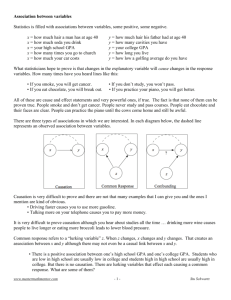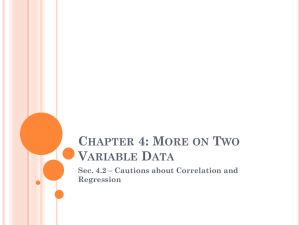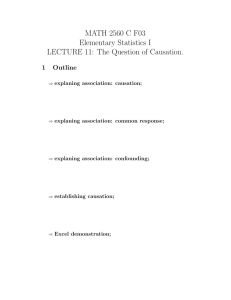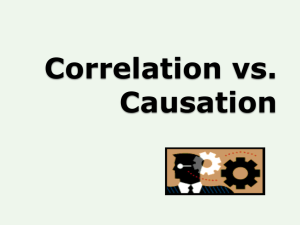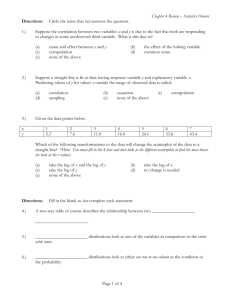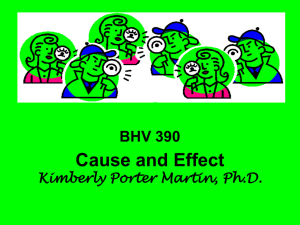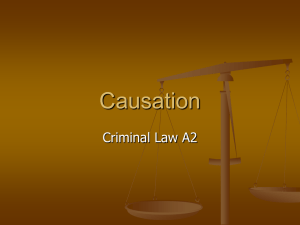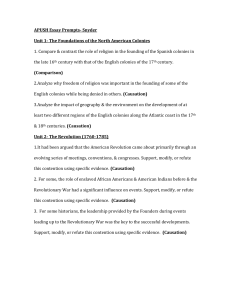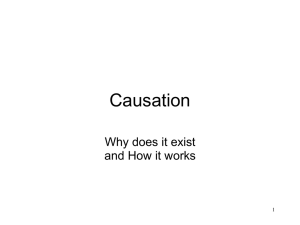4.3 The question of causation
advertisement
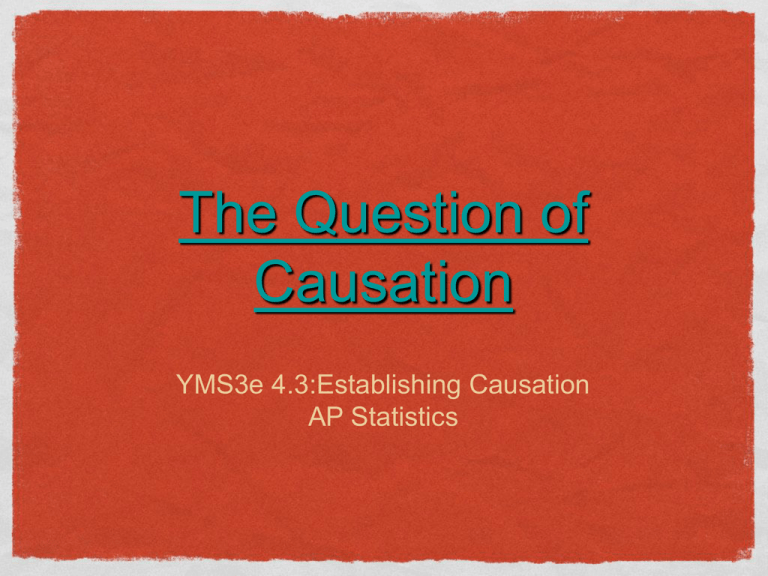
The Question of Causation YMS3e 4.3:Establishing Causation AP Statistics Lurking Variable: A variable that is not among the explanatory or response variable in a study and yet may influence the interpretation of relationships among those variables Lurking Variable: A dentist found a strong correlation between the number of cavities his patients had in a year and the number of apples eaten….What is the lurking variable? Confounding Variable: •May be a lurking variable •One whose effects on the response variable cannot be separated from another possible explanatory variable. (Example will be come later) Beware the post-hoc fallacy “To avoid falling for the post-hoc fallacy, assuming that an observed correlation is due to causation, you must put any statement of relationship through sharp inspection. Causation can not be established “after the fact.” It can only be established through well-designed experiments. Explaining Association Strong Associations can generally be explained by one of three relationships. Causation: x causes y Common Response: x and y are reacting to a lurking variable z Confounding: x may cause y, but y may instead be caused by a confounding variable z Causation Causation is not easily established. The best evidence for causation comes from experiments that change x while holding all other factors fixed. Even when direct causation is present, it is rarely a complete explanation of an association between two variables. Even well established causal relations may not generalize to other settings. Common Response “Beware the Lurking Variable” The observed association between two variables may be due to a third variable (z). Both x and y may be changing in response to changes in z. Consider the “Ice cream sales and Drowning” example...does ice cream actually cause people to drown? The common response was temperature Confounding Two variables are confounded when their effects on a response variable cannot be distinguished from each other. The confounded variables may be either explanatory variables or lurking variables. Confounding Confounding prevents us from drawing conclusions about causation. We can help reduce the chances of confounding by designing a wellcontrolled experiment. Causation, Confounding or Common Response? x=whether a person regularly attends religious y=how long the person lives Confounding x=whether a person regularly attends religious y=how long the person lives Many studies have found that people who are active in their religion live longer than nonreligious people. But people who attend church or mosque or synagogue also take better care of themselves than nonattenders. They are less likely to smoke, more likely to exercise, and less likely to be overweight. The effects of these good habits are confounded with the direct effects of attending religious services. Causation, Confounding or Common Response? x = mother’s body mass index y = daughter’s body mass index Causation x = mother’s body mass index y = daughter’s body mass index A study of Mexican American girls aged 9 – 12 years recorded body mass index (BMI), a measure of weight relative to height, for both the girls and their mothers. People with high BMI are overweight or obese. Causation x = mother’s body mass index y = daughter’s body mass index The study also measured hours of television, minutes of physical activity, and intake of several kids of food. The strongest correlation (r = 0.506) was between the BMI of daughters and the BMI of their mothers. Causation x = mother’s body mass index y = daughter’s body mass index Body type is in part determined by heredity. Daughters inherit half their genes from their mothers. As a result, there is a direct causal link between the BMI of mothers and daughters. Yet the mother’s BMIs explain only 25.6% (that is r2 again) of the variation among the daughters’ BMIs. Other factors, such as diet and exercise, also influence BMI. Even when direct causation is present, it is rarely a complete explanation of an association between two variables. Causation, Confounding or Common Response? x = a high school senior’s SAT score y = the student’s first-year college grade point average Common Response x = a high school senior’s SAT score y = the student’s first-year college grade point average Student who are smart and who have learned a lot tend to have both high SAT scores and high college grades. The positive correlation is explained by the common response to students’ ability and knowledge. Exercises 4.41: There is a high positive correlation: nations with many TV sets have higher life expectancies. Could we lengthen the life of people in Rwanda by shipping them TVs? 4.42: People who use artificial sweeteners in place of sugar tend to be heavier than people who use sugar. Does artificial sweetener use cause weight gain? 4.43: Women who work in the production of computer chips have abnormally high numbers of miscarriages. The union claimed chemicals cause the miscarriages. Another explanation may be the fact these workers spend a lot of time on their feet. Exercises-con’t 4.44: People with two cars tend to live longer than people who own only one car. Owning three cars is even better, and so on. What might explain the association? 4.45: Children who watch many hours of TV get lower grades on average than those who watch less TV. Why does this fact not show that watching TV causes low grades? Exercises-con’t 4.46: Data show that married men (and men who are divorced or widowed) earn more than men who have never been married. If you want to make more money, should you get married? 4.47: High school students who take the SAT, enroll in an SAT coaching course, and take the SAT again raise their mathematics score from an average of 521 to 561. Can this increase be attributed entirely to taking the course?


